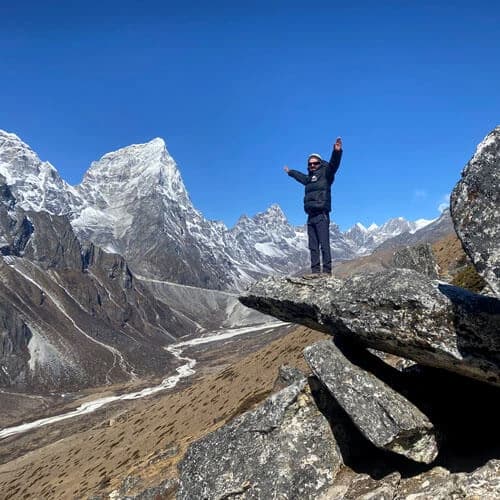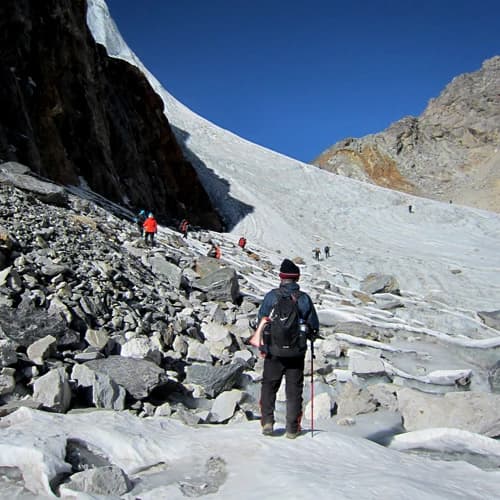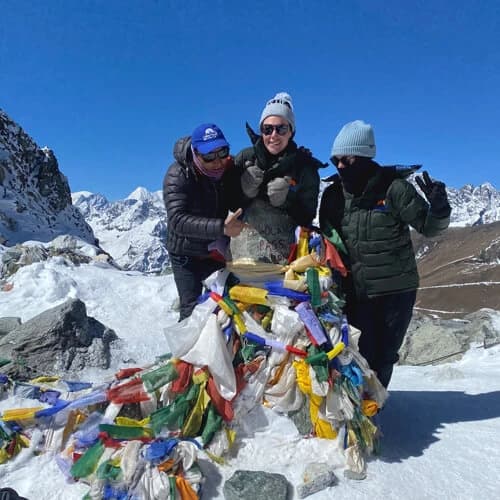Three High Pass Trekking is a remarkable journey beyond the typical Khumbu/Everest region trail and routes. This trek requires physical fitness and stamina, as it involves long, strenuous days of walking at high altitude regions. The challenging hike takes you over three high-altitude passes, including Kongma La (5,535 m), Cho La (5,420 m), and Renjo La (5,360 m). Along the way, you will also have the opportunity to explore the most stunning landscapes of the Everest region. Each pass has its challenges and rewards, including breathtaking panoramic views of Everest, Lhotse, Makalu, and other towering peaks. This Himalayan tour includes iconic landmarks such as Everest Base Camp, Gokyo Lakes, and Tengboche Monastery. So, during this adventure, trekkers can experience the region's natural wonders and the rich culture of the local people. The Everest Two Pass Trekking is an unforgettable journey that every seasoned trekker must experience in their lifetime.
How Difficult is the Everest Three Pass Trek
What is the Difficulty Level of the Everest Three Pass Trekking ?
The Everest 3 Pass Trekking is a strenuous and challenging adventure in the Everest region of Nepal. The journey involves challenging climbs and glacier crossing, increasing the overall trek's difficulty. During this tour, you will cross high-altitude passes, including Kongma La, Cho La, and Renjo La. This trek package is designed for travelers with previous high-altitude trekking as it involves long days of hiking and navigating through steep, rugged terrains. Moreover, trekkers should also prepare for altitude sickness as they ascend to high and remote areas in the Khumbu/Everest region. The remote nature of the trail, besides limited access to medical facilities, adds to the challenge. Overall, the Everest High Pass Trek is a challenging yet rewarding experience best suited for trekkers seeking a thrilling Himalayan adventure.
What makes the Everest Three Pass difficult?
The difficulty of the Everest Three Pass depends on several factors. These include your experience, physical health, adaptability to increasing elevation, and the ability to hike for hours on rugged, steep terrains. It is also important to note that the challenges one might face are completely subjective. To provide you with a better understanding of the concept, we have listed the factors influencing the Everest Three Pass difficulty in detail.
Prior Experience and Fitness Level
The Everest Three Pass is undoubtedly a long and strenuous journey over the rugged landscapes of the Himalayas. To complete this journey, a traveler must have a good physical fitness level, muscular endurance, and stamina. It is also a must for trekkers to have previous experience in high-altitude trekking. The knowledge you gained from your last treks will allow you to adapt and tackle the challenges you might face during this journey. Moreover, you must have a good fitness level as you will have to hike for around 6 to 8 hours on steep and rugged terrains. Having good cardiovascular health is also a bonus, as travelers must make steep ascents with their daypack. Individuals without adequate preparation and training will find the trek difficult and experience extreme exhaustion and fatigue.
Everest 3 High Passes Highlights
- Here is a brief overview of the passes you will cross during this trek
- so you can better understand the package.
- Kongma La: The pass is the highest of the three, at 5,535 m/18,159 ft. Crossing Kongma La offers picturesque views of surrounding glaciers, peaks, and the south face of Lhotse.
- Cho La: Standing at 5,420m/17,782ft, Cho La connects the Everest Base Camp trek route with the beautiful Gokyo Valley. The pass offers travelers marvelous views of the Khumbu region and glaciers.
- Renjo La: The pass is 5,350m/17,520ft above sea level and is renowned for its aesthetic vistas of Everest, Makalu, Lhotse, and the Gokyo Lakes.
Elevation Gain and Risk of Altitude Sickness
The Everest Three Pass takes you to an elevation above 5,000 meters, exposing you to drastic atmospheric changes. The additional low oxygen level at higher altitudes increases the risk of Acute Mountain Sickness or altitude sickness. The condition can lead to serious health complications if not properly managed. Suppose the early signs of the illness are overlooked. In that case, it can develop into HAPE(High-altitude pulmonary edema) or HACE(High-altitude cerebral edema), both life-threatening conditions that require urgent treatment. The symptoms you need to look out for include:
- Lightheadedness/Dizziness
- Nausea/Vomiting
- Shortness of breath
- Insomnia
- Tiredness and fatigue
The risk can be reduced if the trekkers take strict precautions and undergo adequate acclimatization. Here are some important preventive measures you can take to mitigate the early symptoms of altitude sickness.
- Gradual Ascent
- Adequate rest and sleep
- Consumption of carbohydrate-rich meals
- Stay hydrated and drink at least 2 liters of water every day
- Natural remedies include ginger tea, garlic soup, and lemon tea
- Avoid alcohol and highly caffeinated beverages
- Medications such as Diamox
Long Distance Hike on Rugged Terrain
The Everest Three Pass is a long journey from 16 to 20 days. The duration depends on your itinerary, the package chosen, and the pace of the travelers. During this exceptional journey, you will cover a total distance of 166 km/102 miles. For several days of the trek itinerary, travelers have to hike on varied terrains and cross several glaciers of the Everest region. The 6 8-hour hikes can be challenging as your body will be pushed to its limits.
Additionally, the rugged and challenging terrain makes the hike significantly tricky. Trekkers must go on rocky trails, steep ascents, and narrow mountain passes that require careful navigation and constant attention. Often, the path involves rocky slopes, where travelers might lose their footing and cause injury to themselves. Hence, you must be self-sufficient, follow the guide's lead, and be prepared to face any unforeseen circumstance.
Unpredictable Weather Conditions
The weather in the Everest area is generally very unpredictable; this makes it one of the prominent factors that will make the Three Pass Trek harder to accomplish. In general, the complicated terrain and the weather conditions make this trek physically demanding. In most of the trek, snow and ice can accumulate on passes, making the trails treacherous and more challenging to navigate. Freezing temperatures, especially at higher altitudes, often drop below freezing, even during the daytime. This further complicates the situation, possibly leading to frostbite, especially when exposed to skin. Therefore, trekkers must prepare themselves with proper clothing and trekking equipment. Besides, the weather changes could also lead to flight delays and cancellations. The itinerary must be tailored with additional days to avoid such circumstances and ensure a smooth, enjoyable travel experience.
The remoteness of the trek and lack of resources
Everest Three High Pass takes you to an off-beaten track in the secluded parts of the Everest region. The remoteness of the travel can be challenging as travelers will have limited access to medical facilities. In any emergency, evacuation might be difficult due to the complicated terrain and weather conditions. Immediate medical attention often requires a long descent to a lower altitude via mules or horses. Regardless of this complexity, we can assure you of a safe evacuation via a helicopter, which your travel insurance covers. If such circumstances arise, our staff members will provide you with immediate medical attention with the help of a first-aid box and medication. After everything is under control, we will arrange for your swift evacuation via a helicopter to the health facility in the capital.
Basic Accommodation Facilities and Dietary Preference
The accommodation during the Everest Three High Pass includes teahouses, lodges, and guesthouses. In most parts of the trail, these accommodations are well furnished with lavish facilities, which satisfies the needs of the trekkers. However, as the trail ascends higher, the facilities start to get basic due to the lack of resources. In such circumstances, visitors have to compromise and make use of what's provided in the teahouses and lodges. While this is not an issue for most travelers, it can be a challenge for someone with no previous trekking experience. On the other hand, the menu is limited to higher-altitude regions as well. This might be a problem for travelers with special dietary requirements, including people with food allergies. However, we can make the necessary meal arrangements if you make requests while booking the trek. Your cooperation will allow us to arrange specific diet plans rich in vitamins and nutrition to sustain your body during the journey.
Is Everest Three Pass suitable for me?
The Everest Three Pass is suitable for seasoned trekkers who are fit in health and have previous experience with high-altitude trekking. The trekking incorporates steep ascents on rocky terrain, with long days of walking up to 5-8 hours. This will require quite a lot of stamina and endurance from the trek participants. If you have previously completed trekking above 5,000m and can bear the challenges of long-distance hiking, this will be an exciting and rewarding adventure. On the other hand, this trek is not advisable for travelers with no prior experience in trekking, especially people with pre-existing medical conditions. The unpredictable weather conditions and the lack of endurance in facing such situations can also be quite challenging. Regardless, if you are interested in experiencing the adventurous trek in the Himalayas of Nepal, we can recommend and tailor a suitable package for you.
How to prepare for Everest Three Pass?
- We advise all interested participants in the Everest Three Pass trek to dedicate themselves to training. Follow these basic guidelines as a starting point to develop your fitness and stamina.
- Physical Endurance: Begin training at least 3-6 months before your trek. Indulge in cardio exercises like running, cycling, and swimming. Similarly, focus on strengthening your legs and core muscles with weight-lifting exercises.
- Go on hikes: Simulate the experience of high-altitude trekking by participating in hikes around your area. If you don't have such an option, you can walk multiple stairs with a backpack at a slow and gradual pace.
- Mental Preparation: Prepare mentally to face long, hard days of trekking. Keep your spirits high, be patient, and let the weather and other conditions change with the trek.
- Acclimatization and Rest: Provide sufficient acclimatization while trekking. When reaching higher elevations, include rest days to get your body used to the thinner air.
Gears and equipment for Everest Three Pass
An organized packing list is among the crucial factors that will contribute to the overall success of the trek. It provides you with convenience and comfort during your incredible journey in the Himalayas. Look at the list guidance below to understand the essentials you should have for an enhanced travel experience.
- Upper body: Thermal tops, Windproof jacket, Pullover, Waterproof coat.
- Lower body: Undergarments, Trekking pants, Thermal sets, Trousers, Trekking shorts, Waterproof shell pants.
- Head: Sunhat, Beanie, Scarf, Gaiter.
- Hand: Woolen gloves, Insulated gloves.
- Footwear: Trekking Boots, Gaiters, Sandals, Crocs, Socks.
- Backpack & Sleeping Gear: Trekking Backpack, Sleeping Bag & Sleeping Bag Liner.
- Essential Accessories: Personal medication, Skin care products, Toiletries, Towels, Water Bottles, Headlamps, Sunglasses, Trekking Poles, Sun Protection, and a First Aid Kit.
- Tech & Navigation: Camera/Smartphone, Maps or GPS Device & Power Bank.
Tips for making your trek easier
- Don't rush the ascent; maintain a slow and consistent pace to avoid altitude sickness. Prioritize acclimatization with rest days and avoid pushing yourself too hard on steep climbs.
- Drink plenty of water throughout the day to stay hydrated, and carry snacks to keep your energy level high. At high altitudes, it is always better to eat frequent small meals than large meals.
- Carry only the essentials to reduce weight. Keep the focus on lightweight, high-performance gear and pack only what is necessary for comfort, safety, and emergencies.
- Well-fitting, waterproof trekking boots that have been broken in before the trek will prevent blisters and support rocky, uneven terrain.
- Pay attention to early signs of fatigue or altitude sickness, such as headache, dizziness, and nausea. Don't ignore symptoms; take a break, hydrate, and rest if necessary. If symptoms worsen, descend immediately.
- Trekking in remote and challenging conditions can be mentally demanding. Maintain positivity, patience, and flexibility when facing unpredictable weather or difficult terrain.
What is the best time to do the Everest Three Pass ?
The best time for the Everest Three Pass is during the pre-monsoon (March to May) or post-monsoon (September to November) season. During these times, the skies are clear, the temperature gets hot, and the region experiences minimal snowfall.
Do I need a guide and porter for the Everest Three Pass ?
Although one can independently trek, it is recommended to hire both a guide and a porter for safety, navigation, and insight into the culture. A guide will help find routes and mitigate risks,whereas a porter will carry heavy gear to make the trek less demanding on the body.
Is Travel insurance needed for the trek?
Comprehensive travel insurance is highly recommended as it covers loss/theft, delays/cancellations, medical bills, and helicopter evacuation.
What are the needed permits for the Everest Three Pass ?
The permits needed for the Everest Three Pass are Sagarmatha National Park Permit, TIMS card, and Local permits.
Some Most Popular Treks
- Everest Base Camp Trek - 14 Days
- 12 Days Everest Base Camp Trek
- Everest Base Camp Luxury - 14 Days
- Everest Cho La Pass - 17 Days
- Everest High Pass 16 - Days
- Annapurna Base Camp - 13 Days
- Ghorepani Poon Hill - 7 Days
- Annapurna Circuit - 17 Days
- 12 Days Annapurna Circuit Trek
- Manaslu Circuit - 14 Days
- Manaslu Trek 12 Days
- Everest Base Camp with Island Peak - 16 Days
- Everest Luxury Trek with Helicopter Return
- Langtang Valley - 10 Days




